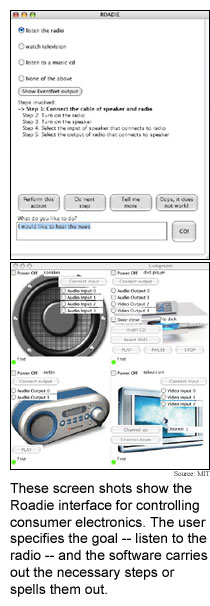
January
23, 2006
Goals
tame home electronics
Take a look at any of today's remote control units and it's clear
that you can do a lot with them. It's also clear that figuring out how
to do any one task takes an inordinate amount of cognitive effort.
 Researchers at the Massachusetts Institute of Technology have
gone back to the drawing board to redesign the consumer electronics interface
from a different angle. Instead of buttons and menu items for each function,
the researchers' Roadie
software presents the user with a list of goals -- for example, record
a movie on a DVD -- and either automatically carries out the steps required
to accomplish the task or guides the user through them.
Researchers at the Massachusetts Institute of Technology have
gone back to the drawing board to redesign the consumer electronics interface
from a different angle. Instead of buttons and menu items for each function,
the researchers' Roadie
software presents the user with a list of goals -- for example, record
a movie on a DVD -- and either automatically carries out the steps required
to accomplish the task or guides the user through them.
The software consists of a user interface, a device interface,
a database of commonsense knowledge, and an artificial intelligence-based
task planner. The commonsense
database helps the system recognize that when a person turns on the
television she is not intending to listen to the radio. The task planner
determines the individual steps needed to meet the user's goal.
The software is designed to allow novices and technophobes to
configure and use combinations of consumer electronic devices. One drawback
to the system is that many consumer electronic devices do not support
third party software.
(A Goal-Oriented Interface to Consumer Electronics Using Planning
and Commonsense Reasoning, Intelligent User Interfaces (IUI) 2006, Sidney
Australia, January 29-February 1, 2006)
Previous news story about the commonsense database: Common
sense boosts speech software, March 23/30, 2005
Context boosts VR interfaces
Context makes a big difference in how humans relate to each other
and their environment. It also turns out to make interacting with virtual
environments better and more efficient.
Researchers from the Massachusetts Institute of Technology and
the University of Southern California have developed a natural language
spoken interface for
virtual reality environments that uses the environment's context -- the
software's understanding of the situation at a given moment -- to narrow
the possibilities that the software has to consider in interpreting the
user's words.
The researchers found that the interface performed better than
standard natural language interfaces when they tested it on the Mission
Rehearsal Exercise virtual environment, which is designed for training
soldiers in peacekeeping duties. (See VR
tool aims high, TRN, May 30, 2001)
The method removes the need for engineers to manually assign meanings
to specific utterances, and it overcomes many of the errors introduced
by the system's automatic speech recognition software.
The interface could be used to improve virtual environments used
for training, evaluation and entertainment.
(Taking Advantage of the Situation: Non-Linguistic Context for
Natural Language Interfaces to Interactive Virtual Environments, Intelligent
User Interfaces (IUI) 2006, Sidney Australia, January 29-February 1, 2006)
Bits and pieces
Caterpillar to butterfly to LED
Dipping butterfly
wings in zinc nitrate and baking them in an oven causes them to curl
up and harden into zinc oxide microtubes with pores. The resulting tubes
could be used as light emitting and controlling devices, chemical catalysts
and drug delivery systems.
(Fabrication of ZnO Microtubes with Adjustable Nanopores on the
Walls by the Templating of Butterfly Wing Scales, Nanotechnology,
February 14, 2006)
Spray-on prosthetics
Adapting a simple, one-step process for spraying
thin layers of plastics to work with phospholipid molecules produces biologically-compatible
membranes. The technique could be used to make artificial organs and other
prosthetic devices.
(Phospholipid Nonwoven Electrospun Membranes, Science,
January 20, 2006)
Bubbles clean up ultrasound
A technique
for producing ultrasonic bubbles in tissue cleans up phantom features
in medical ultrasound diagnostic images. The method, which mimics the
way astronomers correct for distortions caused by imperfect lenses and
the atmosphere, promises better medical images of soft tissue.
("Ultrasonic Stars" for Time-Reversal Focusing Using Induced Cavitation
Bubbles, Applied Physics Letters, January 16, 2006)
Nanowire mats flex muscle
Sheets
made from single-wall carbon nanotubes coated with platinum nanoparticles
can be made to move like piezoelectric ceramics and are stronger than
human skeletal muscles. The nanowire sheets could be used to make artificial
muscles for robots and nanodevices like grippers.
(Hybrid Platinum/Single-Wall Carbon Nanotube Nanowire Actuators:
Metallic Artificial Muscles, Nanotechnology, February 14, 2006)
RSS Feeds: News Blog Books New: TRN's Internet Services TRN's Jobs Center News: Research News Roundup Research Watch blog Features: View from the High Ground Q&A How It Works Buy an ad link |
|
| Advertisements: |
|
Ad links: Clear History
Buy an ad link
|
TRN
Newswire and Headline Feeds for Web sites
|